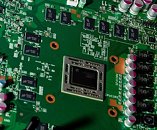Thursday, May 23rd 2013

Xbox One Chip Slower Than PlayStation 4
After bagging chip supply deals for all three new-generation consoles -- Xbox One, PlayStation 4, and Wii U, things are looking up for AMD. While Wii U uses older-generation hardware technologies, Xbox One and PlayStation 4 use the very latest AMD has to offer -- "Jaguar" 64-bit x86 CPU micro-architecture, and Graphics CoreNext GPU architecture. Chips that run the two consoles have a lot in common, but also a few less-than-subtle differences.
PlayStation 4 chip, which came to light this February, is truly an engineer's fantasy. It combines eight "Jaguar" 64-bit x86 cores clocked at 1.60 GHz, with a fairly well spec'd Radeon GPU, which features 1,156 stream processors, 32 ROPs; and a 256-bit wide unified GDDR5 memory interface, clocked at 5.50 GHz. At these speeds, the system gets a memory bandwidth of 176 GB/s. Memory isn't handled like UMA (unified memory architecture), there's no partition between system- and graphics-memory. The two are treated as items on the same 8 GB of memory, and either can use up a majority of it.Xbox One chip is a slightly different beast. It uses the same eight "Jaguar" 1.60 GHz cores, but a slightly smaller Radeon GPU that packs 768 stream processors, and a quad-channel DDR3-2133 MHz memory interface, which offers a memory bandwidth of 68.3 GB/s, and holding 8 GB of memory. Memory between the two subsystems are shared in a similar way to PlayStation 4, with one small difference. Xbox One chip uses a large 32 MB SRAM cache, which operates at 102 GB/s, but at infinitesimally lower latency than GDDR5. This cache cushions data-transfers for the GPU. Microsoft engineers are spinning this off as "200 GB/s of memory bandwidth," by somehow clubbing bandwidths of the various memory types in the system.
The two consoles also differ with software. While PlayStation 4 runs a Unix-derived operating system with OpenGL 4.2 API, Xbox One uses software developers are more familiar with -- a 64-bit Windows NT 6.x kernel-based operating system, running DirectX 11 API. Despite these differences, the chips on the two consoles should greatly reduce multi-platform production costs for game studios, as the two consoles together have a lot in common with PC.
Source:
Heise.de
PlayStation 4 chip, which came to light this February, is truly an engineer's fantasy. It combines eight "Jaguar" 64-bit x86 cores clocked at 1.60 GHz, with a fairly well spec'd Radeon GPU, which features 1,156 stream processors, 32 ROPs; and a 256-bit wide unified GDDR5 memory interface, clocked at 5.50 GHz. At these speeds, the system gets a memory bandwidth of 176 GB/s. Memory isn't handled like UMA (unified memory architecture), there's no partition between system- and graphics-memory. The two are treated as items on the same 8 GB of memory, and either can use up a majority of it.Xbox One chip is a slightly different beast. It uses the same eight "Jaguar" 1.60 GHz cores, but a slightly smaller Radeon GPU that packs 768 stream processors, and a quad-channel DDR3-2133 MHz memory interface, which offers a memory bandwidth of 68.3 GB/s, and holding 8 GB of memory. Memory between the two subsystems are shared in a similar way to PlayStation 4, with one small difference. Xbox One chip uses a large 32 MB SRAM cache, which operates at 102 GB/s, but at infinitesimally lower latency than GDDR5. This cache cushions data-transfers for the GPU. Microsoft engineers are spinning this off as "200 GB/s of memory bandwidth," by somehow clubbing bandwidths of the various memory types in the system.
The two consoles also differ with software. While PlayStation 4 runs a Unix-derived operating system with OpenGL 4.2 API, Xbox One uses software developers are more familiar with -- a 64-bit Windows NT 6.x kernel-based operating system, running DirectX 11 API. Despite these differences, the chips on the two consoles should greatly reduce multi-platform production costs for game studios, as the two consoles together have a lot in common with PC.

148 Comments on Xbox One Chip Slower Than PlayStation 4
Xbox One => DX11.1, 768 ALUs(256 ALUs(from Jaguar SoC)+ 512 ALUs(Ripped from Kaveri lol))
The clock-speeds for the CPU cores actually appear to be around 2.0 GHz, nominally.
www.anandtech.com/show/6972/xbox-one-hardware-compared-to-playstation-4
In it you can see in detail how the memory bandwidth is shared between different components on both consoles.
He also reviewed Kavini, the architecture behind the Jaguar cores shared by both consoles here:
www.anandtech.com/show/6974/amd-kabini-review
It's AMD's latest, but as a low power part it's really meant to compete against ARM and Atom processors, not desktop class processors like Ivy Bridge or Piledriver, future's not looking very bright for consoles in terms of CPU power, as even dual core desktop parts handily beat Jaguar...
Funny thing is, the fact that PS4 has a faster GPU won't mean much to game developers, as they usually program games for the lowest common denominator hardware, and then port their software to other platforms :p
im no expert, but shouldnt Sony start using DX11? or wont they because DX is MS tech?
I think it will be awile before devs can actually take advantage full advantage of either system and by then it won't really matter which system is better....it doesn't now and I see no reason for it to matter in the future.
Besides MS is giving greedy Devs exactly what they want and then some...
www.nextpowerup.com/news/991/nvidia-ps4-gpu-is-too-cheap-and-too-weak.html
My bet is that both companies wanted similar architecture to make development cheaper. Yes they probably worked together on this after learning last-gen that independent dev is absurdly costly. AMD was most certainly the lowest bidder.
Then they probably wanted the cpu/gpu to be developed by the same company for several reasons. Cost, synergy. Next gen if the Tegra has evolved to 32 cores and nvidia becomes more established in the processor department maybe they will have a better chance.
The previous Xbox's were loud because the fan they selected was badly designed, simply put, it had nothing to do with heat output.
We have desktop CPUs running a lot hotter than it's console counterpart, yet even the most mainstream cooling system is silent or near silent. If Microsoft or Sony want a quiet fan, they will source one, if they don't it's because they're cutting costs or feel that noise isn't a priority. It has little to do with heat constraints.
Xbox 360 had inferior hardware to the PS3 but Xbox 360 won out because of its early launch.
Despite the Xbox One being a bit slower, I don't think it will be noticeable. I saw it coming a mile away that MS was going to use DX and PS was going to use OpenGL. For idealism sake, I would like to see Sony succeed but I'm afraid I have to agree with Ford. The
game industrybusinesses in general flock to where the money is.